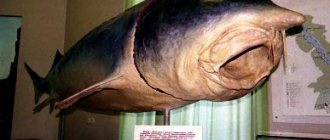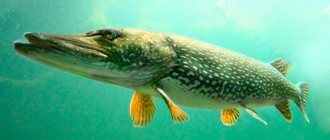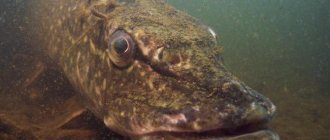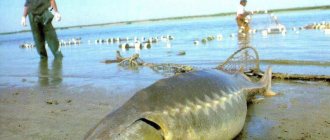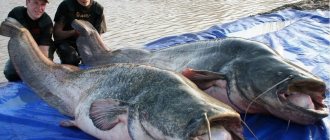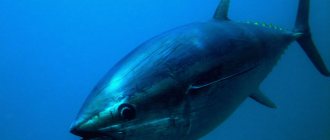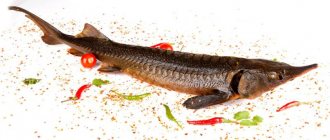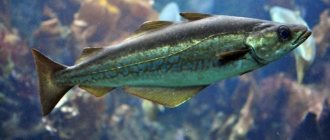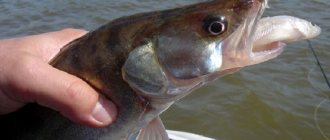Habitat and gastronomic properties
These are two classes of sturgeon fish that are similar in appearance, but significantly different in their habitat and feeding method. Sterlet prefers to lead a sedentary lifestyle in the bottom part of clean flowing water bodies, feeding on larvae, zooplankton and small fish. The sturgeon can migrate long distances; during the spawning period it goes to sea; its food is based on fish, aquatic worms, crustaceans and shrimp. Therefore, the taste properties of sterlet and sturgeon meat have certain differences. A true gourmet can easily distinguish them by taste.
- Gastronomic properties. The main taste differences between these representatives of the sturgeon family are that sterlet meat is very tender and quite fatty (up to 30% fat). Sturgeon has a denser and more fibrous meat structure, and its fat content exceeds 15%.
- Caviar. The most valuable product that sterlet and sturgeon provide is caviar of the highest quality, and it can be distinguished by size and color. Sterlet caviar is smaller, dark, very rich in color. Sturgeon caviar is much larger and has a greenish tint.
The difference between sterlet and sturgeon is quite noticeable, despite the fact that visually they have certain similarities. But at the same time, both representatives of sturgeon are considered not only a very expensive and delicious type of fish, but also a product that contains a large amount of substances and microelements useful for the human body.
Sterlet is a commercial fish and belongs to the sturgeon family. As you know, this species is known for its taste and nutritional value.
This fish is freshwater and is found in almost all rivers of Russia. She, unlike other sturgeons, constantly lives in the reservoir, and not only during spawning.
In the material you will learn more about the properties of sterlet, see photos and characteristics, and also find out how to eat and prepare it correctly.
Classification of sturgeons.
According to the fishbase.org database, there are 17 species of sturgeon (data from 10/2016):
- Acipenser baerii – Siberian sturgeon;
- Acipenser brevirostrum – Blunt sturgeon;
- Acipenser dabryanus – Korean sturgeon;
- Acipenser fulvescens – Lake sturgeon;
- Acipenser gueldenstaedtii – Russian sturgeon;
- Acipenser medirostris – Green sturgeon (Pacific);
- Acipenser mikadoi – Sakhalin sturgeon;
- Acipenser naccarii – Adriatic sturgeon;
- Acipenser nudiventris – Thorn;
- Acipenser oxyrinchus – American Atlantic sturgeon;
- Acipenser persicus – Persian sturgeon;
- Acipenser ruthenus – Sterlet;
- Acipenser schrenckii – Amur sturgeon;
- Acipenser sinensis – Chinese sturgeon;
- Acipenser stellatus – Stellate sturgeon;
- Acipenser sturio – Atlantic sturgeon;
- Acipenser transmontanus – White sturgeon.
Fossil species of sturgeon:
- Acipenser albertensis † - Campanian stage of the Upper Cretaceous - early Paleocene 83.5-61.7 million years ago
- Acipenser eruciferus † - Campanian - Maastrichtian stages of the Upper Cretaceous 83.5-65.5 million years ago
- Acipenser molassicus†
- Acipenser ornatus†
- Acipenser toliapicus † - Lutetian stage of the Eocene 48.6-40.4 million years ago, Europe and northern Asia
- Acipenser tuberculosus†
What is the difference between beluga, kaluga and sturgeon?
The largest beluga: confirmed facts
Beluga, kaluga and sturgeon are fish of the sturgeon family. Not surprisingly, they have many similarities, due to which fishermen and buyers may not distinguish beluga from sturgeon or kaluga from beluga. But in our article we will talk in detail about each type of fish, as well as their main differences.
Beluga
The sturgeon has an oblong body, which can reach three meters in length, and an elongated head. The oral cavity of this fish is completely devoid of teeth, and in front of the mouth there are four “antennae” with which the sturgeon searches for food. This type of fish lives mainly on the bottom and feeds on mollusks, worms and small sprat.
Kaluga can reach five meters in length, and its maximum weight is 700 kilograms. The fish feeds on smaller relatives, mainly chum salmon and pink salmon. River Kaluga eats bottom species of fish. The head is elongated, but not as pointed as that of the beluga and sturgeon.
Beluga is the largest fish from the sturgeon family. It can reach as much as nine meters in length, and its weight in some cases reaches a ton. At a young age, this fish feeds on small crustaceans, and when it reaches a large size, it switches to larger foods in the form of sprat, anchovy and herring.
Beluga and fisherman
And now more about the differences between these sturgeons:
- Beluga has a small caudal fin, unlike sturgeon and kaluga, whose fin is elongated upward and wider.
- “Whiskers” are present in all varieties of sturgeon fish, but in sturgeon they are less pronounced and not so long.
- Also, the difference lies in the number of rays on the dorsal fin, but only ichthyologists can correctly count them. If an ordinary person succeeds, it will be with great difficulty.
- Kaluga and beluga have several bony protrusions that run along the body. The beluga's body is covered with scales between these protrusions, while the kaluga has bare skin in this area.
Outwardly, at first glance, it is quite difficult to distinguish kaluga from beluga or sturgeon, but if you take a closer look at these fish, taking note of the recommendations from our article, you can detect differences.
Beluga close up
How to distinguish sterlet from sturgeon
What is the biggest pig in the world?
The sturgeon genus has existed on planet Earth for many millennia and belongs to the elite class of commercial fish. Gourmet dishes for the preparation of which sturgeon was used were at all times considered a decoration for the festive tables of pharaohs, kings, and emperors. Sterlet and sturgeon are considered the most famous varieties of this delicious fish among modern consumers. Both representatives of sturgeon belong to the same family, but have a certain list of differences in appearance and taste.
There are other signs that help to understand how sterlet differs from sturgeon. The main difference between two outwardly similar representatives of the same genus of fish, from a zoological point of view, is their official classification.
Biological differences between sterlet and sturgeon
In addition to belonging to different classes, there are a number of biological characteristics of sturgeon and sterlet that help to understand the difference between these two representatives of the same genus.
1. Size of the individual. Most fish of the sturgeon family are impressive in size (up to 6 meters in length) and gain a lot of weight (more than 100 kilograms). Sterlet is an exception in this series. The length of an adult fish rarely exceeds 125 centimeters, and the maximum weight is 6 kilograms.
2. Head shape and size. You can distinguish a sturgeon by its large and wide head and short nose. The sterlet's head is small, and its nose is very long and pointed, with a mustache in the form of a fringe. Such differences can be seen even in photographs of these sturgeon representatives.
3. Body color and structure. The color of sturgeon fish can be from light gray to black, and there is practically no difference in the color of sterlet and sturgeon. But the number of lateral bony scutes (bugs) that both sturgeon and sterlet have will help to accurately determine which class the individual belongs to. The sturgeon can have up to 70 bugs, while the sterlet has 10-15 fewer scutes.
Moreover, all sturgeons belong to one of the most ancient zoological branches, which is called cartilaginous. Their main difference from other known species of fish is the absence of a bony spine, the function of which is performed by a cartilaginous chord. Fry of any type of fish have a similar structure until their skeletal system becomes stronger.
Habitat and gastronomic properties
These are two classes of sturgeon fish that are similar in appearance, but significantly different in their habitat and feeding method. Sterlet prefers to lead a sedentary lifestyle in the bottom part of clean flowing water bodies, feeding on larvae, zooplankton and small fish. The sturgeon can migrate long distances; during the spawning period it goes to sea; its food is based on fish, aquatic worms, crustaceans and shrimp. Therefore, the taste properties of sterlet and sturgeon meat have certain differences. A true gourmet can easily distinguish them by taste.
- Gastronomic properties. The main taste differences between these representatives of the sturgeon family are that sterlet meat is very tender and quite fatty (up to 30% fat). Sturgeon has a denser and more fibrous meat structure, and its fat content exceeds 15%.
- Caviar. The most valuable product that sterlet and sturgeon provide is caviar of the highest quality, and it can be distinguished by size and color. Sterlet caviar is smaller, dark, very rich in color. Sturgeon caviar is much larger and has a greenish tint.
The difference between sterlet and sturgeon is quite noticeable, despite the fact that visually they have certain similarities. But at the same time, both representatives of sturgeon are considered not only a very expensive and delicious type of fish, but also a product that contains a large amount of substances and microelements useful for the human body.
Nutrition
As soon as the beluga fry were born, they have not yet reached enormous size - their main diet consists of ordinary river plankton or caviar, and the fry of other smaller fish species. When the beluga fry have already grown up, their food is no longer limited to such trifles. They perfectly eat young sturgeon and love young sturgeon or similar fish species.
Until the age of two, a young beluga does not particularly change its diet when transitioning from fresh to salt water. Afterwards she becomes a real predator. Now she is no longer interested in any small fish, crustaceans or plankton. The predatory beluga is ready and capable of hunting larger prey, and its wild natural appetite only spurs it on. There may be cases of eating even their own weaker belugas, when strong young animals cannot fully satisfy their appetite. The main “menu” of the young beluga predator becomes only fish.
Now everything depends only on the beluga itself, the time of year and the type of reservoir. The predator finds more food in seawater than in fresh rivers. In spring and summer, hunting activity is also higher than in winter. But even taking into account such factors, the beluga feeds and hunts constantly throughout the year. Loves to eat prey at depth.
There were cases when large beluga sturgeons ate even small seal calves and large sturgeon fish. The beluga's appetite does not need to be borrowed from anyone - this is a fact.
Interesting Facts
The biggest horse in the equestrian world, who is she?
There are several points that would be of interest to anyone who wants to get to know the giant fish better.
- Many who are new to the inhabitants of water bodies often wonder how to spell beluga or beluga? In fact, these are two completely different animals. The beluga whale is a mammal from the Narwhal family, a rare species of toothed whale. It is considered one of the largest mammals in the aquatic environment. Beluga is a freshwater fish with a bizarre appearance and gigantic size.
- Beluga is translated from Latin as “pig”. And for good reason. Its appearance really does look a little like a pig, and the beluga is also not at all picky when it comes to food.
- The largest beluga existed 200 million years ago. Its length reached 9 meters. During the process of evolution, she did not change her appearance, only decreased slightly in weight. This can be seen in the photo.
- During the cold winter season, the predator may practically not eat. There have been cases where a giant was caught while winter fishing, and its stomach was completely empty.
- The male and female do not care about their offspring after spawning. And when they swim from the sea to the river to breed, they jump high out of the water column. And besides, already in those distant times, meat and caviar were expensive, and only the rich could afford them.
- Previously, beluga dishes were served exclusively on the table of kings, since catching it was prohibited.
- Beluga, due to its gigantic body length and large mass, can live for about a century.
All interesting facts were collected by specialist zoologists. In addition to its unusual appearance, which has remained unchanged, the fish has a lot of stories about its origin and successful catches by fishermen.
Here is such an amazing and unusual large beluga fish that appeared on planet Earth when there were still dinosaurs. It has overcome many millions of years, survived a variety of natural disasters, and today it overcomes any changes in its environment and proudly emerges victorious.
Growth and reproduction
Males reach sexual maturity by 12-14 years, females become capable of reproduction a little later - by 18 years. In addition, females, in addition to a certain age, need to reach a weight of more than 50 kg.
The breeding season occurs in April and May. Individuals ready for this period swim away from the seas into deep rivers with fast currents. Optimal temperatures for reproduction are considered to be 9-17 degrees. Spawning usually begins on days with maximum water levels in the river.
The eggs are deposited on a hard (preferably rocky) bottom, where the fast current will provide a continuous supply of oxygen. The required depth for throwing it is about 10-15 meters. The eggs, which become sticky after fertilization and attach to the bottom due to new properties, come out large. And how much caviar comes out at a time! The number varies from 200 thousand to 8 million. When the fry grow from the eggs, the female swims back to the sea with them. Such migration in adult fish can occur once every 2-3 years. They can spawn intermittently during their lives, on average, about 8-9 times. Occasionally, adult fish die after spawning.
Sometimes beluga breeds with its relatives - sterlet, stellate sturgeon, thorn. As a result, hybrids are born that have some distinctive features in structure (this is noticeable in some photographs), but not in behavior.
How to distinguish counterfeit
Counterfeiting elite vodka is the scourge of modern Russia
To protect yourself, pay attention to the cork - it should be embossed, with the Synergy logo engraved. The embossed label has metallic inclusions
The fish is carved by hand and is a true work of art. A plastic fish and a paper label are sure signs of a fake.
If you purchase vodka from the Golg Line category, make sure there is a serial number on the label. The cork is cast from sealing wax and the kit includes a hammer for breaking. All this is packed in a leather case (a sign of counterfeit is a cardboard box).

